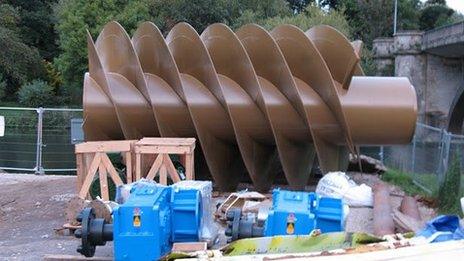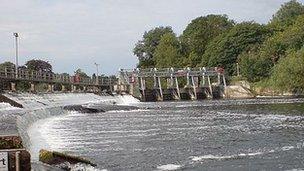River Thames hydropower schemes 'could harm ecology'
- Published

One of two giant turbines that will generate power for Windsor Castle was installed on Tuesday
As one of two 40-tonne hydropower turbines is lowered into place near Windsor Castle on the River Thames, a group of river conservationists are not joining in with the celebrations.
The two Archimedes screws represent for some, in particular the Environment Agency, a great green innovation.
They are the first to be installed on the River Thames, at Romney Weir, and will be used to produce energy for the royal household.
The production of 300KW of electricity is expected to reduce CO2 output by 500 tonnes a year, said the Environment Agency's Barry Russell, the hydro-power project leader.
'No scientific proof'
As a result, nine other weirs along the river have been earmarked to produce green energy.
Some are slated for completion as soon as 2012, and this is what concerns the Thames Anglers Conservancy (TAC).
"We don't oppose hydro power," said TAC secretary David Harvey.
"But what hasn't been produced so far is any science to back up proof that it will do no damage to the weir pools".

Sunbury Weir could have two 3.4m diameter Archimedes screws
He said the Environment Agency needed to "suspend all hydropower" plans until long-term assessments have been carried out.
Mr Harvey added the potential damage to the river's ecology would mean fish would change their spawning habitat and invertebrates would not breed there.
However, the Environment Agency claimed its studies showed the three-bladed Archimedes screw turbines would not harm fish when installed within the correct guidelines.
It said project leaders would monitor what happened after the screws were installed.
Mr Russell said that realistically the hydropower projects took a lot longer to finish than the estimated completion dates.
'Very new'
"There are a lot of processes that have to be undertaken," he said, "empowerment licences, flood relief planning consent, then there are the technical aspects and consultation with local communities".
"This is still very new for the Thames," he added, "the Romney scheme has taken almost 10 years to get to the position it has.
"We expect subsequent ones to happen more quickly than that, but this isn't something that can be bolted onto the weir in a matter of weeks".
The other weirs proposed for hydropower developments are:
Teddington Weir, London
Sunbury Weir, Surrey
Bell Weir, Egham, Surrey
Viaduct Weir, Surrey
Boveney Weir, Windsor, Berkshire
Boulter's Weir, Maidenhead, Berkshire
Marlow Weir, Buckinghamshire
Goring Weir, Oxfordshire
Osney Weir, Oxfordshire

The four turbines proposed for Boulter's Weir in Maidenhead would produce up to 530KW of electricity
While there are other hydropower schemes elsewhere in the UK, Mr Russell said this is the first on a major river that is called the 'run of the river' type of scheme - using water that is naturally making its way down the river to generate electricity.
He said the Teddington Weir could produce 500KW - enough to power up to 800 houses.
However, it is this weir that conservation groups are most concerned about as it is the last before the tidal river.
"The tidal river is under such pressure at the moment from pollution and abstraction for use as drinking water," said Mr Harvey.
"The river is heavily over-managed, there's no flow on there at all - not enough flow to even turn the turbines I believe.
"Adding in hydropower to the mix, it makes us very fearful for the future of the Thames."
The Environment Agency said the projects would help it support the government's 15% target of creating renewable energy by 2020.
- Published25 October 2011
- Published24 August 2011
- Published20 August 2011
- Published30 April 2011